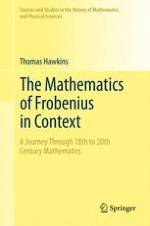2013 | OriginalPaper | Buchkapitel
15. Characters and Representations After 1897
verfasst von : Thomas Hawkins
Erschienen in: The Mathematics of Frobenius in Context
Verlag: Springer New York
Aktivieren Sie unsere intelligente Suche, um passende Fachinhalte oder Patente zu finden.
Wählen Sie Textabschnitte aus um mit Künstlicher Intelligenz passenden Patente zu finden. powered by
Markieren Sie Textabschnitte, um KI-gestützt weitere passende Inhalte zu finden. powered by
